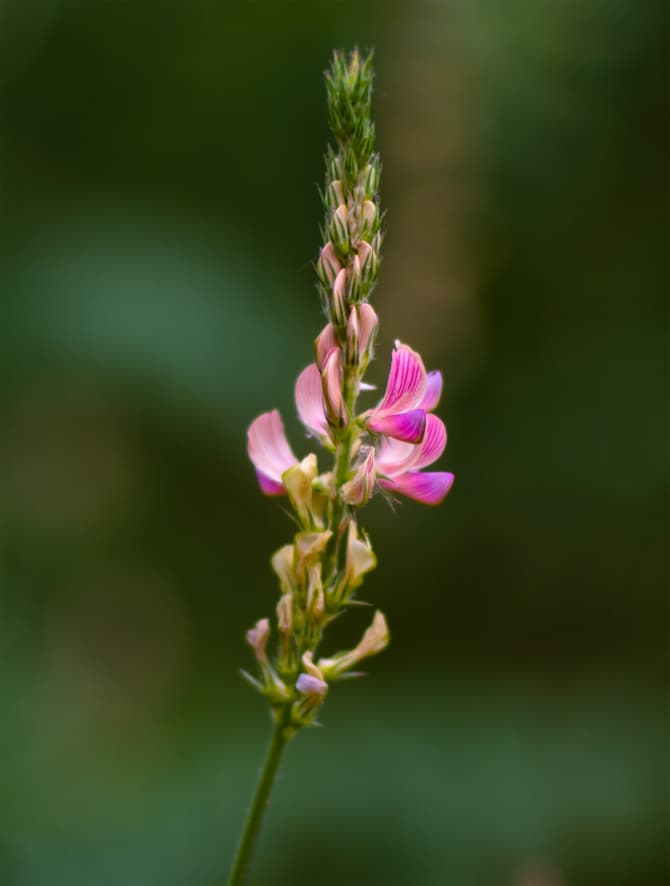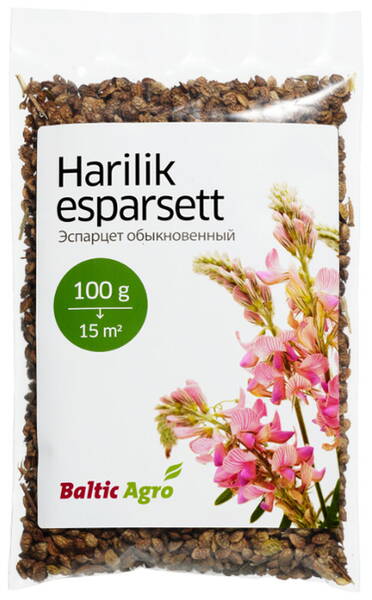Koristeellinen, hunajaa sisältävä ja lääkinnällinen viherlannoituskasvi.
100 g = 15 m2.
Pieni monivuotinen pensas hernekasvien heimosta, jolla on liilanvärisiä (valkoisia, keltaisia, violetteja tai vaaleanpunaisia) kukkia, joiden runko on runsaasti piikkejä peittänyt.
Lääkinnällisten ominaisuuksiensa lisäksi esparsettia käytetään paitsi rehukasvina ja hunajakasvina, myös kasvina, joka palauttaa hyvin maaperän hedelmällisyyden.
Pääjuuri on erittäin haarovainen, tunkeutuu maaperään 1–2 metrin syvyyteen. Varsi on pysty, tuuhea, jopa 90 cm korkea. Lehdet ovat monimutkaisia, parilehdykkäisiä, tummanvihreitä. Kukat kerätään lyhyinä, tiheinä harsoina. Kukkii heinäkuussa.
Erittäin kaunis ja koristeellinen viherlannoituskasvi ja erittäin arvokas rehukasvi, erinomainen hunajakasvi. Suositellaan viljelyyn koristekasvina, maaperän parantamiseen ja kuivattamiseen syvemmältä, rehu- ja lääkekasvina.
Väliviljelykasvina se rikastuttaa maaperää typellä. Se tuottaa suuren vihermassan ja torjuu rikkaruohoja. Se parantaa maaperän ominaisuuksia voimakkaan ja hyvin kehittyneen juuristonsa ansiosta. Se on kuivuutta kestävä ja tauteja kestävä. Se ei sovellu happamille ja turvepitoisille maille. Se on erittäin hyvä hunajakasvi. Kirkkaan vaaleanpunaisten kukkiensa ansiosta sitä käytetään usein monivuotisissa niittykukkasekoituksissa.
Kylvö toukokuusta alkaen. Kylvösyvyys on 1–1,5 cm. Kylvömäärä: 6–8 g/m² (puhdas kylvö), 1–2 g/m² (seoskylvö). Vihreän massan saanto on 5–6 kg/m².

Esparsetti. Bot. syn.: Onobrychis sativa L., Hedysarum onobrychis L.
Ensimmäisenä vuonna esparsetti tuottaa yhden varren ja alkaa sitten pensastua. Se kukkii puutarhojen kukinnan päätyttyä: toukokuun lopussa–kesäkuun lopussa pitkään (2–3,5 viikkoa) kevään kukinnan lopun ja kesän hunajakasvien kukinnan alun välisenä aikana.
Poikkeuksellisen runsaan meden ja siitepölyn erityksen vuoksi lähes kaikki hunajankeruuseen ja mehiläistarhojen pölytykseen tuodut lentävät mehiläiset keskittyvät kukkiviin esparsettiviljelmiin.
Viljelmien täydellisen pölytyksen varmistamiseksi on välttämätöntä, että mehiläistarhoja on neljä mehiläisyhdyskuntaa hehtaaria kohden. Tarhojen sijoittelun tulisi varmistaa mehiläisten tasaisin jakautuminen viljelmille. Hyvin suurilla viljelmillä tarhat tulisi sijoittaa enintään 1,5 km:n etäisyydelle toisistaan. Pienillä viljelmillä mehiläistarha tulisi sijoittaa viljelmän keskelle tai sen lähelle. Yhden hehtaarin esparsettikylvöstä saadaan keskimäärin noin 100 kg hunajan.
Esparsettiviljelytekniikka.
Esparsetti, toisin kuin alfalfa, on vähemmän maaperän suhteen vaativa ja sille on ominaista kyky imeä huonosti liukenevia ravinteita. Se ei siedä happamia maita, mutta kasvaa hyvin hiekka- ja hiekkapitoisilla mailla sekä kaikentyyppisillä karbonaattimailla. Esparsetin edeltäjinä voivat olla useat eri kasvit.
Se voidaan kylvää puhtaana, katekasvin alle tai seokseen muiden vilja- ja palkokasvien kanssa. Esparsetin maanmuokkaus koostuu kuorinnasta 5–7 cm syvyyteen. Jos juuria imevät rikkaruohot ovat pahasti saastuneet, kuorinta toistetaan 2–3 viikon kuluttua ja sitten kyntö. Keväällä pelto äestetään kahteen riviin ja rivien välinen kylvö tehdään samanaikaisesti peitekasvin kanssa jyvä-heinäkylvökoneilla. Talvikasvien alle kylvettäessä kylvetään lautaskylvökoneilla peitekasvin rivien poikki. Esparsetin siemenet alkavat itää +1–2 °C:n lämpötilassa, optimaalinen lämpötila on +18–25 °C. Esparsetti on hyvin talvenkestävä ja kuivuutta kestävä. Se ei siedä varjostusta hyvin.
Arvioitu kylvömäärä (ha kohden): arovyöhykkeellä 70–80 kg ja metsä-arolla 80–100 kg. Siementen sijoitussyvyys raskailla mailla on 3–4 cm, kevyillä mailla 4–5 cm.
Esparsetti alentaa veren kolesterolitasoja, lisää hemoglobiinia ja on tehokas impotenssin, heikkojen erektioiden ja diabeteksen hoidossa.
Hoitojakso, johon kuuluu puoli lasillista hauduketta juotuna yöllä kuukauden ajan, voi muuttaa minkä tahansa luuserin aistikkaaksi "machoksi"!
Haudukeresepti: kaada yksi ruokalusikallinen kuivattua, murskattua esparsettia 300 ml:aan kuumaa vettä ja anna hautua 4–6 tuntia termospullossa. Juo valmistettua hauduketta 3–4 kertaa päivässä ennen aterioita.
Esparsettia käytetään lääkinnällisten ominaisuuksiensa lisäksi paitsi rehukasvina ja hunajakasvina myös kasvina, joka palauttaa hyvin maaperän hedelmällisyyden.












